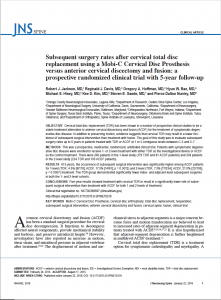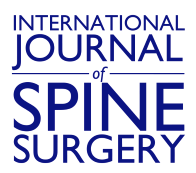
Abstract
OBJECTIVE: Cervical total disc replacement (TDR) has been shown in a number of prospective clinical studies to be a viable treatment alternative to anterior cervical discectomy and fusion (ACDF) for the treatment of symptomatic degenerative disc disease. In addition to preserving motion, evidence suggests that cervical TDR may result in a lower incidence of subsequent surgical intervention than treatment with fusion. The goal of this study was to evaluate subsequent surgery rates up to 5 years in patients treated with TDR or ACDF at 1 or 2 contiguous levels between C-3 and C-7. METHODS This was a prospective, multicenter, randomized, unblinded clinical trial. Patients with symptomatic degenerative disc disease were enrolled to receive 1- or 2-level treatment with either TDR as the investigational device or ACDF as the control treatment. There were 260 patients in the 1-level study (179 TDR and 81 ACDF patients) and 339 patients in the 2-level study (234 TDR and 105 ACDF patients). RESULTS At 5 years, the occurrence of subsequent surgical intervention was significantly higher among ACDF patients for 1-level (TDR, 4.5% [8/179]; ACDF, 17.3% [14/81]; p = 0.0012) and 2-level (TDR, 7.3% [17/234]; ACDF, 21.0% [22/105], p = 0.0007) treatment. The TDR group demonstrated significantly fewer index- and adjacent-level subsequent surgeries in both the 1- and 2-level cohorts. CONCLUSIONS Five-year results showed treatment with cervical TDR to result in a significantly lower rate of subsequent surgical intervention than treatment with ACDF for both 1 and 2 levels of treatment. Clinical trial registration no.: NCT00389597 ( clinicaltrials.gov ).
To Read The Full Article Click Here
PMID: 26799118 DOI: 10.3171/2015.8.SPINE15219






